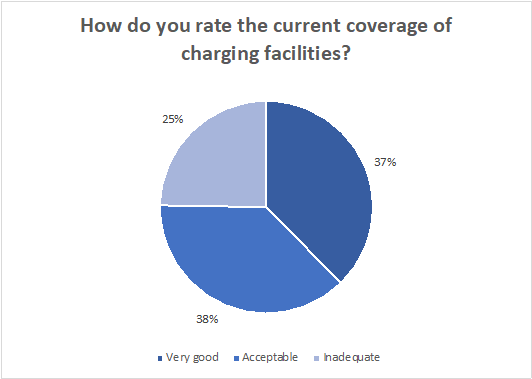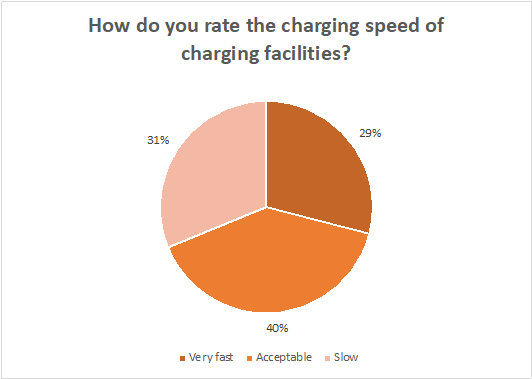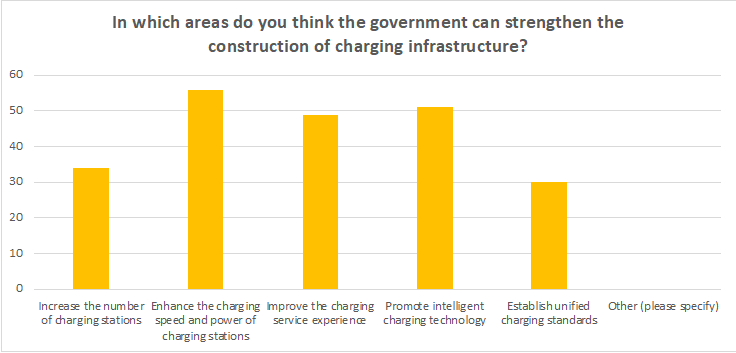1. Introduction
Electric vehicles (EVs) have emerged as a promising solution to reduce air pollution and mitigate climate change. In China, the government has been actively promoting the development of the EV industry in recent years. A key aspect of this development has been the deployment of charging infrastructure like charging piles, which is critical to the growth and success of the EV market as it addresses the challenge of range anxiety and enhances consumer confidence in EVs. Despite the progress made in the deployment of charging infrastructure in China, there is still a gap in the understanding of the impact of such infrastructure on the sales of EVs. Furthermore, the central government has set ambitious targets for EV consumption and charging infrastructure deployment. However, the effectiveness of such policies in promoting EV sales is still under debate. Therefore, this study aims to examine the relationship between China's charging infrastructure deployment and the growth of the EV industry, while controlling for other important factors that may influence the EV market, such as GDP, fuel prices, emission standards, and policy incentives. By doing so, the study will provide valuable insights into the effectiveness of China's charging infrastructure deployment policies in driving the EV market and offer guidance for policymakers to make better decisions.
Overall, this study is significant because it has the potential to inform the future development of China's EV industry. By examining the relationship between charging infrastructure deployment and EV sales, policymakers can make better decisions about how to allocate resources to support the growth of the EV market. In addition, the study can serve as a model for other countries seeking to promote the adoption of EVs.
2. Literature Review
Electric vehicles (EVs) are becoming increasingly popular to reduce carbon emissions and address environmental concerns. However, the deployment of charging infrastructure is crucial for their widespread adoption. This literature review examines several studies that investigate the relationship between the deployment of charging infrastructure and the adoption of EVs.
In Wu and Yang's study, the authors explored the impact of insufficient public charging piles on EV sales in China. The study revealed that the lack of charging infrastructure had a negative effect on EV sales and improving its availability could promote EV adoption [1].
Haidar and Rojas's study used mixed-effect regression to examine the impact of charging infrastructure on EV sales. They found the need for a diverse range of charging infrastructure, including both fast and slow charging options, to meet the needs of different types of EV users [2].
Wang, Sun, and Huang's study focused on the planning and construction of EV charging infrastructure in the United States. The authors reviewed the existing EV charging infrastructure in the US, identified the challenges in planning and constructing EV charging stations. The study provided valuable insights into the planning and construction of EV charging infrastructure [3].
Tan, Wu, Wei, and Yu's study analysed the development status, strategic choice, and business model of China's charging pile industry. The authors reviewed the current situation of China's charging pile industry, provided insights into the strategic choices and business models that could be adopted to address these challenges and promote the sustainable development of the EV charging infrastructure in China [4].
Lili's article interpreted and examined China's EV charging infrastructure policy. The study reviewed the policy background, goals, and implementation strategies of China's EV charging infrastructure policy. The study showed that the policy played a crucial role in promoting the deployment of EV charging infrastructure in China [5].
Dong and Lin's study provided valuable insights into the use of stochastic models to predict the behaviour of battery electric vehicle (BEV) drivers. The study revealed that the developed stochastic model accurately predicted BEV driving behaviour, particularly in terms of battery charge depletion and trip duration [6].
The studies reviewed demonstrate that the availability and density of charging infrastructure have a significant impact on EV sales and adoption. The lack of public charging facilities negatively affects EV sales, and government intervention is necessary to support the deployment of charging infrastructure. The studies also emphasize the need for a diverse range of charging options to meet the needs of different types of EV users. Additionally, the review provides insights into the planning and construction of EV charging infrastructure, strategic choices and business models for the EV charging industry, and the use of stochastic models to predict BEV driving behaviour.
According to the above discussion, this paper is going to focus on exploring the following questions. How has the deployment of charging infrastructure in China impacted the sales of electric vehicles in the country? To what extent do factors such as GDP, fuel prices, and emission standards influence the relationship between charging infrastructure deployment and electric vehicle sales in China? What has the government done in the field of charging infrastructure deployment to promote electric vehicle industry in China?
3. Methodology
3.1. Data
Table 1: Data collection.
Ye-ar | Charging Piles(*10000) | GDP(*100000000 yuan) | Gas price(yuan per ton) | EV sales | Car sales | Revenues(yuan) |
2022 | 520 | 1210207.2 | 9328.43 | 6872282 | 26849351 | 36883 |
2021 | 261.7 | 1149237 | 7923.31 | 3507189 | 26248287 | 35128 |
2020 | 167.2 | 1013567 | 5936.84 | 1322946 | 25267553 | 32189 |
2019 | 111.4 | 986515.2 | 7169.72 | 1206124 | 25754482 | 30733 |
2018 | 86.5 | 919281.1 | 8257.81 | 1247320 | 28038947 | 28228 |
2017 | 41 | 832035.9 | 6875.22 | 767759 | 28941381 | 25974 |
2016 | 20.6 | 746395.1 | 7325.59 | 501708 | 27938931 | 23821 |
2015 | 6.5 | 688858.2 | 7816.24 | 328910 | 24562975 | 21966 |
2014 | 2.8 | 643563.1 | 9698.45 | 21819 | 23488603 | 20167 |
2013 | 2.25 | 592963.2 | 10100 | -- | 21994229 | 18311 |
Data of the number of charging piles (public and private), GDP, fuel prices, revenues, and expenditures data in China and electric vehicles from government statistics, Electric Vehicle Charging Infrastructure Promotion Alliance, and Wind database as shown in table 1.
The study also utilized questionnaire to collect data on individuals' knowledge of government efforts to build new energy vehicle infrastructure. The survey consisted of 12 questions and was distributed using the online platform “Questionnaire Star”.
3.2. Method
By utilizing multiple regression analysis using Stata and Excel as analysis tools, the paper aims to investigate the relationship between the number of charging piles and the sales of electric vehicles in China. Descriptive statistical analysis will be used to provide a detailed overview of the collected data. The findings will be presented through charts and graphs to provide a more intuitive understanding of the results. By utilizing multiple regression analysis, the paper can effectively examine the changes in the number of charging piles and electric vehicle sales.
The initial model:
Electric vehicle sales = β0 + β1 ×sum of charging piles + β2 × GDP + β3 × Gasoline prices + β4 × Car sales + β5 × Per capita disposable income + ε
Table 2: Descriptive Statistics Table.
Variable | Obs | Mean | Std. | Min | Max |
Piles | 10 | 121.995 | 163.3223 | 2.25 | 520 |
GDP | 10 | 878262.3 | 212708 | 592963.2 | 1210207 |
Gas | 10 | 8043.161 | 1325.514 | 5936.84 | 10100 |
EV | 9 | 1752895 | 2167528 | 21819 | 6872282 |
Cars | 10 | 2.59e+07 | 2167509 | 2.20e+07 | 2.89e+07 |
Income | 10 | 27340 | 6356.445 | 18311 | 36883 |
Table 3: Correlation Table.
EV | Piles | GDP | Gas | Cars | Income | |
EV | 1.0000 | |||||
Piles | 0.987*** | 1.0000 | ||||
GDP | 0.847*** | 0.878*** | 1.0000 | |||
Gas | 0.350 | 0.078 | -0.300 | 1.0000 | ||
Cars | 0.171 | 0.245 | 0.463 | -0.528 | 1.0000 | |
Income | 0.829*** | 0.863*** | 0.998*** | -0.353 | 0.472 | 1.0000 |
In conducting the regression analysis, we had multicollinearity issues among the control variables according to table 2 and 3. To address this problem, we performed variable selection by first conducting correlation coefficient analysis, examining the collinearity level of the variables using variance inflation factors (VIF), and identifying the variables that needed to be removed. Ultimately, certain control variables were removed to ensure the accuracy and reliability of the regression results.
The final model:
Electric vehicle sales = β0 + β1 ×sum of charging piles + β2 ×Gasoline prices + β3 × Car sales + ε
4. Results
Table 4: Regression Results.
(1) | (2) | |
VARIABLES | EV | EV |
Piles | 12,463.205*** | 12,196.445*** |
(19.42) | (26.56) | |
Gas | 166.964 | 230.569* |
(1.05) | (2.43) | |
Cars | 0.126* | |
(2.20) | ||
Constant | -1238138.587 | -5029255.709* |
(-1.02) | (-2.50) | |
Observations | 9 | 9 |
R-squared | 0.982 | 0.991 |
Robust t-statistics in parentheses
*** p<0.01, ** p<0.05, * p<0.1
Table 5: Adjusted Correlation Table.
EV | Piles | Gas | Cars | |
EV | 1.000 | |||
Piles | 0.987*** | 1.000 | ||
Gas | 0.350 | 0.078 | 1.000 | |
Cars | 0.171 | 0.245 | -0.528 | 1.000 |
Table 6: VIF Test.
Variable | VIF | 1/VIF |
Gas | 1.20 | 0.830565 |
Cars | 1.13 | 0.884830 |
Piles | 1.12 | 0.890641 |
Mean VIF | 1.15 |
Table 7: White's Test.
White's test | |
H0: | Homoskedasticity |
Ha: | Unrestricted heteroskedasticity |
chi2(8) = 9.00 | |
Prob > chi2 = 0.3423 | |
The regression model output shows that there is a significant and positive relationship between the sales of electric cars and the number of charging stations, gasoline prices, and total car sales according to table 3 to 7. All coefficients are positive and significant. The model has a high goodness of fit, as indicated by an R-squared value of 0.991, suggesting that the model explains 99.1% of the variance in the sales of electric cars. After conducting VIF and White's tests, there is no multicollinearity or heteroscedasticity. Overall, these results suggest that an increase in the number of charging stations, higher gasoline prices, and higher total car sales are associated with an increase in the sales of electric cars.

Figure 1: Coverage of charging piles.

Figure 2: Speed of charging piles.
Based on the survey data, pie charts were created to illustrate people's perceptions of the coverage area and speed of charging stations, as shown in figure 1 and 2.

Figure 3: How to strengthen the construction of charging infrastructure.
Figure 3 shows the areas where people believe the government should focus its efforts to strengthen the construction of charging infrastructure, with many respondents indicating a need to improve the charging speed of charging stations. Additionally, the number of people who chose to increase the number of charging stations was significantly lower.
5. Discussion
Interestingly, the survey results showed that a greater proportion of respondents felt that improving charging speed was more important than increasing the number of charging piles to enhance the charging infrastructure. This finding challenges the conventional assumption that the primary focus for improving charging infrastructure is to increase the number of charging piles. Instead, the results suggest that addressing the issue of slow charging speed may be a more pressing concern for promoting the adoption of electric vehicles in China. This phenomenon may be due to respondents considering their own experiences and actual needs when answering the question. While building more charging stations is one way to improve charging infrastructure, in practical use, charging speed is indeed a more urgent and realistic issue. Especially for those considering purchasing electric vehicles but had range anxiety, they need fast and convenient charging services to meet their daily travel needs. Gasoline cars only need a few minutes to fill up and go, while electric cars need to queue for over an hour to charge. Due to the slow charging speed and the need to wait in line, longer parking times and more planning are required for long-distance travel. Therefore, policymakers should take this into consideration when designing and implementing charging infrastructure development policies and initiatives to meet the needs and preferences of potential electric vehicle consumers.
According to the government website, the Chinese government has implemented several policies and initiatives to promote the development of the EV industry and charging infrastructure deployment in the country. For example, in terms of charging infrastructure deployment, the government has established national and local-level policies and incentives to encourage the construction and application of charging piles. These policies include financial subsidies, tax incentives, and land use policies. Furthermore, the government has implemented technical standards and regulations to ensure the safety and reliability of charging infrastructure. Overall, the Chinese government has played a significant role in promoting the development of the electric vehicle industry and charging infrastructure deployment in the country. Further research could examine the effectiveness of these policies and initiatives in achieving their intended goals and the potential for further improvements.
Overall, this study provides important insights into the economic implications of charging infrastructure deployment for electric vehicles in China. The findings suggest that charging infrastructure deployment has a significant impact on electric vehicle sales and that government policies and actions can play a critical role in promoting the adoption of electric vehicles. However, the study also highlights the need for further investment in charging infrastructure development to address the challenges and barriers to adoption and promote the development of the EV industry in China.
6. Conclusion
In conclusion, this study highlights the importance of charging infrastructure deployment in promoting the adoption of electric vehicles in China. The regression analysis results indicate that the number of charging piles is positively related to electric vehicle sales, while gasoline prices and overall car sales also have a positive influence. The survey questionnaire results reveal that while the majority of respondents consider the coverage area and charging speed of charging piles to be acceptable, a quarter of respondents feel that the coverage area is still insufficient, and 31% feel that the charging speed is too slow. Notably, more respondents consider improving charging speed as a priority over increasing the number of charging piles. The study emphasizes the critical role of government policies and actions in promoting the development of the electric vehicle industry and charging infrastructure deployment in China and highlights the need for further investment in charging infrastructure development to support the growth of the electric vehicle industry. However, the study also acknowledges several limitations, including the need for robustness checks, collecting data at a more detailed level, and expanding the sample size of the survey. Overall, this study provides valuable insights into the economic implications of charging infrastructure deployment for electric vehicles in China and can guide policymakers in designing and implementing effective policies and initiatives to promote the adoption of electric vehicles.
References
[1]. Wu, S., & Yang, Z. (2020). Availability of public electric vehicle charging pile and development of electric vehicle: evidence from China. Sustainability, 12(16), 6369.
[2]. Haidar, B., & Rojas, M. T. A. (2022). The relationship between public charging infrastructure deployment and other socio-economic factors and electric vehicle adoption in France. Research in Transportation Economics, 95, 101208.
[3]. Xiaoxi Wang, Zhi Sun & Yue Huang. (2017). Current planning methods and practices of electric vehicle charging facilities in the United States. Modern Urban Research (01), 82-89.
[4]. Tan, Q., Wu, P., Wei, T., & Yu, Z. (2020). Research on the development status, strategic choice, and business model of China’s charging pile industry. Journal of Physics: Conference Series, 1637(1), 012083 (6pp).
[5]. Lili, L. I. (2017). Interpretation and prospect of China’s electric vehicle charging infrastructure policy. Distribution & Utilization, 34(1), 2-7.
[6]. Dong, J., & Lin, Z. (2014). Stochastic modelling of battery electric vehicle driver behaviour. Transportation Research Record Journal of the Transportation Research Board, 2454, 61-67.
Cite this article
Ding,J. (2023). Economic Implications of Charging Infrastructure Deployment for Electric Vehicles in China: An Empirical Analysis. Advances in Economics, Management and Political Sciences,50,268-275.
Data availability
The datasets used and/or analyzed during the current study will be available from the authors upon reasonable request.
Disclaimer/Publisher's Note
The statements, opinions and data contained in all publications are solely those of the individual author(s) and contributor(s) and not of EWA Publishing and/or the editor(s). EWA Publishing and/or the editor(s) disclaim responsibility for any injury to people or property resulting from any ideas, methods, instructions or products referred to in the content.
About volume
Volume title: Proceedings of the 2nd International Conference on Financial Technology and Business Analysis
© 2024 by the author(s). Licensee EWA Publishing, Oxford, UK. This article is an open access article distributed under the terms and
conditions of the Creative Commons Attribution (CC BY) license. Authors who
publish this series agree to the following terms:
1. Authors retain copyright and grant the series right of first publication with the work simultaneously licensed under a Creative Commons
Attribution License that allows others to share the work with an acknowledgment of the work's authorship and initial publication in this
series.
2. Authors are able to enter into separate, additional contractual arrangements for the non-exclusive distribution of the series's published
version of the work (e.g., post it to an institutional repository or publish it in a book), with an acknowledgment of its initial
publication in this series.
3. Authors are permitted and encouraged to post their work online (e.g., in institutional repositories or on their website) prior to and
during the submission process, as it can lead to productive exchanges, as well as earlier and greater citation of published work (See
Open access policy for details).
References
[1]. Wu, S., & Yang, Z. (2020). Availability of public electric vehicle charging pile and development of electric vehicle: evidence from China. Sustainability, 12(16), 6369.
[2]. Haidar, B., & Rojas, M. T. A. (2022). The relationship between public charging infrastructure deployment and other socio-economic factors and electric vehicle adoption in France. Research in Transportation Economics, 95, 101208.
[3]. Xiaoxi Wang, Zhi Sun & Yue Huang. (2017). Current planning methods and practices of electric vehicle charging facilities in the United States. Modern Urban Research (01), 82-89.
[4]. Tan, Q., Wu, P., Wei, T., & Yu, Z. (2020). Research on the development status, strategic choice, and business model of China’s charging pile industry. Journal of Physics: Conference Series, 1637(1), 012083 (6pp).
[5]. Lili, L. I. (2017). Interpretation and prospect of China’s electric vehicle charging infrastructure policy. Distribution & Utilization, 34(1), 2-7.
[6]. Dong, J., & Lin, Z. (2014). Stochastic modelling of battery electric vehicle driver behaviour. Transportation Research Record Journal of the Transportation Research Board, 2454, 61-67.









